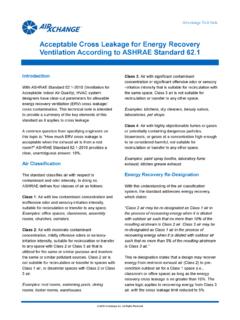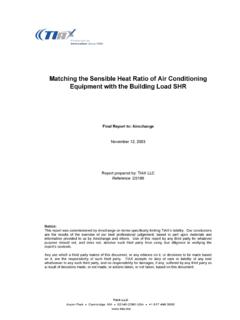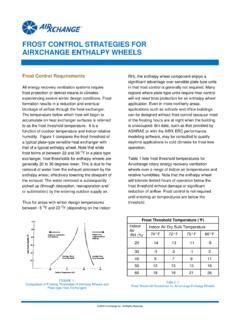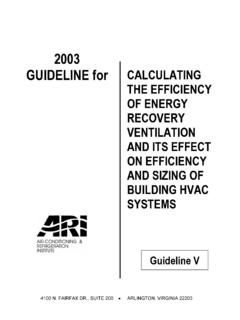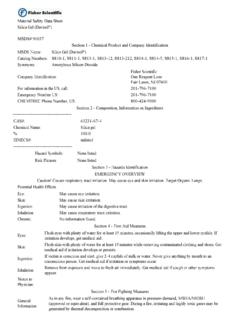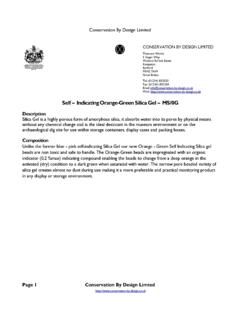Transcription of Use of Type A Silica Gel in Airxchange Energy Recovery ...
1 Airxchange Tech Note Use of Type A Silica Gel in Airxchange Energy Recovery ventilation Wheels Introduction more. 1 gram of Type A Silica gel exhibits an internal surface area of approximately 800 square meters, or Energy Recovery ventilation when properly applied to stated another way; a teaspoonful has an internal an HVAC system adds substantial heating and area equivalent to a football field including the two cooling capacity, provides ongoing operating savings, end zones. and improves overall system Energy efficiency.
2 In order to maximize these benefits, many systems Adsorption and Desorption employ a total Energy wheel , also known as an Characteristics of Type A Silica Gel enthalpy wheel , which transfers heat and moisture between the exhaust and incoming fresh air streams. Type A Silica gel adsorbs and desorbs gas molecules, components, through a process of Moisture transfer in a total Energy wheel is made molecular attraction. Molecules form a single layer possible by using a desiccant. There are numerous on the surface and remain in gas phase.
3 Adsorption types of desiccants available in the market. This of component molecules is driven primarily by three paper outlines the benefits of using Type A Silica gel factors: relative vapor pressure of the component, desiccant and address the risk of pollutant cross competition' with other components, and the contamination in comfort HVAC applications. molecule's polarity. What is Silica Gel Impact of relative vapor pressure on Silica gel adsorption capacity Silica Gel is an inert, amorphous form of Silica , synthetically manufactured from the chemical In a typical building environment, there are many reaction between sulfuric acid and sodium silicate.
4 Different components in air. Silica gel's adsorbent The internal structure of Silica gel is composed of a capacity is directly correlated to the component's vast network of inter-connected microscopic pores. relative vapor pressure, which is defined as the ratio Standard Silica gels can adsorb more than 40% of of partial pressure to vapor pressure (P/Ps). their own weight of water. There are over 25. different types of Silica gels each with their own Figure 1 demonstrates the adsorption capacity for unique moisture adsorption/desorption water of Type A Silica gel versus relative vapor characteristics.
5 Pressure. This curve is similar for other components. As relative vapor pressure of a component Silica gel is the highest capacity desiccant available approaches zero, Silica gel's adsorption capacity also today, an obvious benefit in enthalpy wheel approaches zero. Table 1 illustrates the relative applications. Its adsorption characteristics are a vapor pressure of various components using result of its highly porous nature creating a huge concentration limits set by OSHA. surface area. These pores vary in size: Type A.
6 Silica gel used by Airxchange has pore sizes As illustrated in Table 1, relative vapor pressures (P/. averaging 22 angstroms in diameter, whereas other Ps) for components other than water are extremely Silica gels have pore sizes up to 100 angstroms or low. For example, the relative vapor pressure of 2007 Airxchange Inc. All Rights Reserved Figure 1: Representation of Adsorption Curve for Water of Since water exhibits a relative vapor pressure that is Airxchange Silica Gel at Constant Temperature between 72 and million times the components listed in Table 1, water molecules are the first to Adsorption Capacity of Silica Gel by Weight (%).
7 80. occupy available locations on the Silica gel surface. 70. Components with lower relative vapor pressures are then left to compete with each other for the few 60 remaining locations further reducing Silica gel's adsorption of any one component. 50. 40 Polarity and molecular attraction 30. In addition to it's overwhelming presence and 20 subsequent relative vapor pressure, water's high Relative vapor pressure of water at polarity gives it an additional advantage. Molecules 10 50% RH. attach to Silica gel through molecular attraction, accordingly, the higher the polarity of the component, the stronger attraction it will have to Silica gel.
8 Water Relative Vapor Pressure (P/Ps) has among the highest polarity of all molecules. The combination of these factors limits the adsorption water is 5,646 times that of carbon dioxide at typical capacity, and hence cross contamination, believed to indoor conditions. Given the low relative vapor be on the order of 1-2% for components other than pressure of contaminants other than water, Type A water. Silica gel's effective adsorption capacity is very low At this low level, cross contamination is essentially a and, therefore, is less likely to adsorb contaminants.
9 Non-issue when one considers ASHRAE standards. ASHRAE standard currently categorizes Competition' with other molecules air into different classes. The standard permits re- designation of Class 2 and 3 air to Class 1 as long as An additional factor adversely impacting Silica gel's carry over is less than 10% and 5% respectively. For adsorption capacity for any one component is the more information on ASHRAE classes of air see number of different types of components in the air. Airxchange 's tech note on the subject.
10 There is limited space on the Silica gel surface, so molecules must compete with one another to occupy the available adsorption sites. Table 1: Calculation of Relative Vapor Pressures for Various Components Concentration1 Relative Vapor Pressure Multiple of Water Pressure Component (ppm) (P/Ps) Versus Component2. Water 14,900 1. Isopropyl Alcohol 400 72. Ammonia 50 87,639. Carbon Dioxide 5,000 5,646. Formaldehyde .75 3,406,109. 1. Concentrations are OSHA limits for 8 hour exposure. Typical buildings should be well below these levels.
